Leaf Feeders
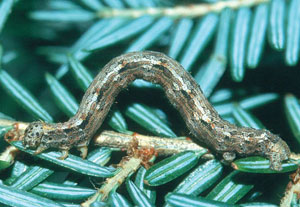
Connecticut Agricultural Experiment Station,
Connecticut Agricultural Experiment Station, Bugwood.org
Adult moths of the Hemlock looper have a wingspan of almost 1.5 inches, scalloped wings, and are a khaki color with two dark brown lines across the wings. Caterpillars reach 1.25 inches and can be many colors, from tan to green to black. They are inchworms and move in the fashion characteristic of that group. Eggs hatch in May-June and caterpillars feed until July-August. Adults emerge in fall and mate, laying overwintering eggs. Symptoms include partially eaten needles, a scorched appearance, and pile of green needles beneath the tree.
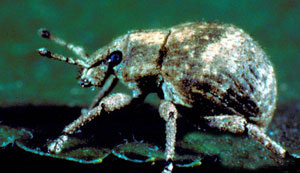
University of Georgia , University of Georgia, Bugwood.org
Two-banded Japanese weevil adults are about 1/4 inch long and pear shaped. Unlike other weevils, which have long snouts, this weevil has a stout, short snout. Adults have a mottled appearance, with grey and brown blotches giving them an almost camouflage-like appearance. There are two distinct bands that form across the back of the elytra. Larvae look like other weevils -- small, white, and legless. The adults feed along the edges of leaves, making notches at first, then tattered edges. In heavy infestations, whole leaves may be consumed. They overwinter as eggs, larvae, and adults. Overwintering adults resume feeding in May and produce the next generation with new adults emerging in June-July.
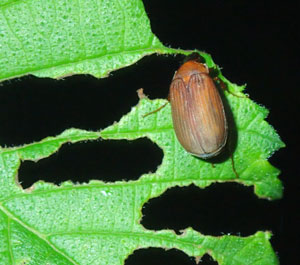
Whitney Cranshaw, Colorado State University, Bugwood.org
Asiatic garden beetle adults are around 1/2 inch long and shaped like a Japanese beetle. They are brown and feed on many different plants at night. The larval stage is a C-shaped white grub that tends to live in and feed on overgrown turf areas. Generally, the larvae are not a pest but can damage plants occasionally. Adults will consume leaves and flowers and are attracted to lights. There is one generation per year, with adults most active in July and August. The overwintering stage is the last grub instar
Sap Feeders
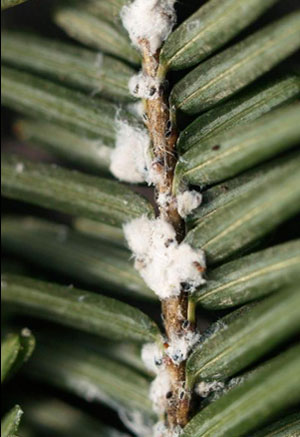
Bruce Watt, University of Maine, Bugwood.org
The most noticeable sign of the Hemlock woolly adelgid is the white, woolly mass that surrounds the actual insect. The adelgid itself is about 1/32 inch and is a reddish-purple color. They settle and develop at the base of hemlock needles. As an invasive species, they are capable of devastating large swathes of trees relatively rapidly. Their feeding reduces new shoot growth, changes needles to a grey-green color, causes needle drop, and will eventually kill the tree. Eggs hatch in March and nymphs will settle to develop over the next few weeks. A new generation is produced in April-May. These adelgids will pause development in the summer and complete their life cycle over the winter to produce the next generation in March. For more information, see Entfact 452.
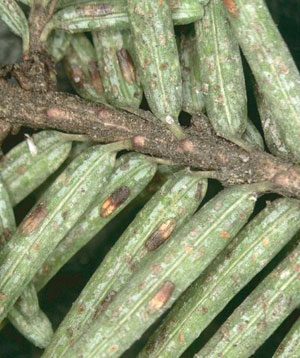
Lorraine Graney, Bartlett Tree Experts, Bugwood.org
Adult Elongate hemlock scale females are elongated ovals with a waxy covering that has a similar coloration to ear wax. Younger scales have a coating that is more of an amber color. As they feed, you may notice yellow-banding on needles, yellowing, and needle loss. Populations can build to a point where multiple scales are piled on top of one another. There are two generations per year. Crawlers are active throughout the summer but peak times are June-July.
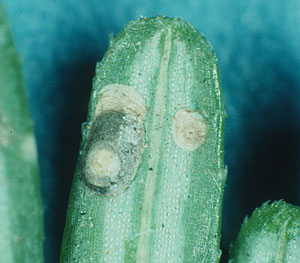
Jim Stimmel, Pennsylvania Department of Agriculture, Bugwood.org
The outer coating can be round or oval, but both male and female Hemlock scale have a gray coloration. Damage and life cycle is very similar to the elongate hemlock scale.
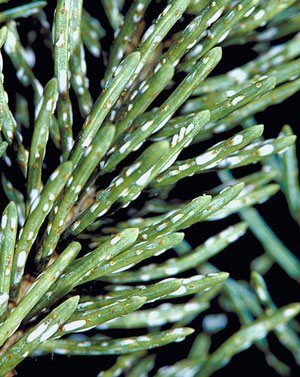
James B. Hanson, USDA Forest Service, Bugwood.org
the mature Pine needle scale cover is elongated and vaguely feather-like in shape. There is a yellow oval at one tip while the rest is white. Symptoms include yellow spots on needles, browning, branch dieback, and upon closer inspection, a frosted appearance to the tree (due to numbers of white scales). Pine needle scale overwinters as eggs that hatch in May-June. A second generation is produced in July-August.
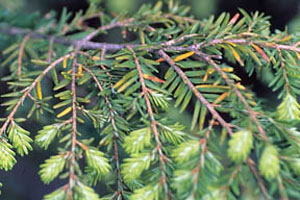
damage: University of Illinois Extension
Hemlock rust mite is a very tiny, non-gall forming mite. The mites are triangular in shape and have only four legs. They puncture needles and their feeding causing small pale dots to form. As damage progresses, the needles will yellow and fall off prematurely. Because they are primarily spring feeders, the foliage at the tips of the branches that developed after feeding ceased will appear normal. Older foliage farther back on the branch will show feeding damage or be bare from needle drop. Hemlock rust mite overwinters as eggs on the needles.
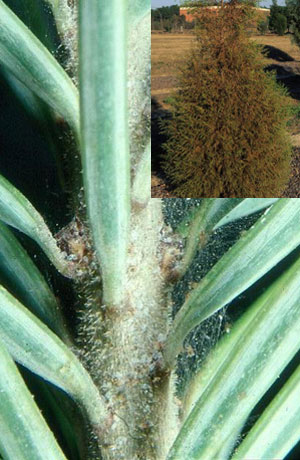
damage (inset): John Ruter, University of Georgia, Bugwood.org;
close-up: Ward Strong, BC Ministry of Forests, Bugwood.org
Spruce spider mite adults are 1/64 inch and can be dark brown, reddish, or dark green in color. They are cool season mites and problems can peak early in the growing season or in the cooler summer or autumn months. They create patchy bronzing damage, dieback, and premature needle drop.
Root Feeders
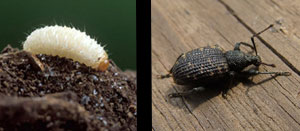
grub: Peggy Greb, USDA Agricultural Research Service, Bugwood.org ;
adult: Cheryl Moorehead, Bugwood.org
Black vine weevil grubs are white legless larvae with yellow brown or red heads that live in the soil and feed on plant roots. Moderate root feeding may cause plants to show signs of drought stress. Girdling can occur and nutrient transmission is disrupted, occasionally leading to death of the plant. The adults (0.5 inch long) are dark snout beetles that may chew crescent-shaped holes in leaves while feeding at night. Normally there is one generation per year with the larva overwintering. Pupation and adult emergence occurs in the spring. Sometimes adults may overwinter which can result in damage occurring from larvae earlier in the season.